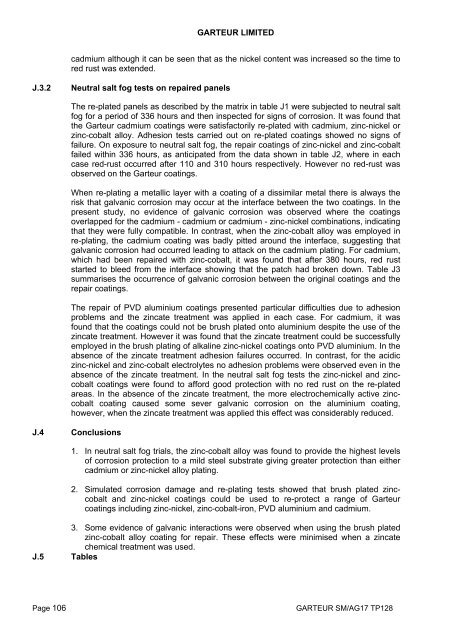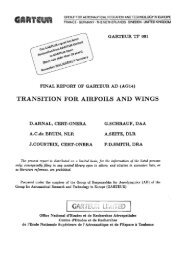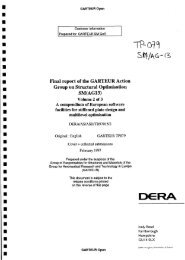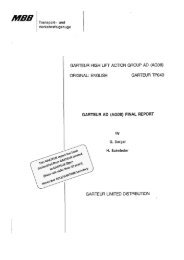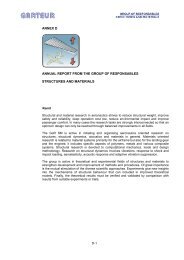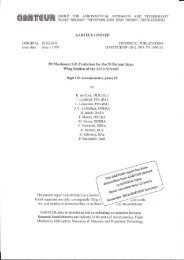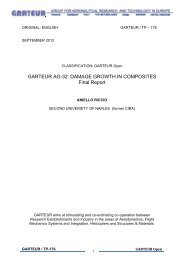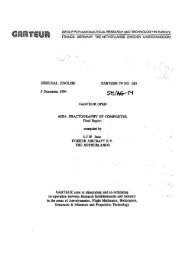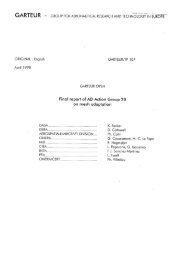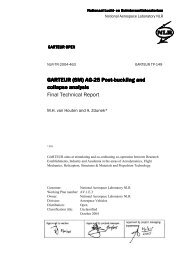Cadmium Substitution - garteur
Cadmium Substitution - garteur
Cadmium Substitution - garteur
You also want an ePaper? Increase the reach of your titles
YUMPU automatically turns print PDFs into web optimized ePapers that Google loves.
GARTEUR LIMITED<br />
cadmium although it can be seen that as the nickel content was increased so the time to<br />
red rust was extended.<br />
J.3.2<br />
Neutral salt fog tests on repaired panels<br />
The re-plated panels as described by the matrix in table J1 were subjected to neutral salt<br />
fog for a period of 336 hours and then inspected for signs of corrosion. It was found that<br />
the Garteur cadmium coatings were satisfactorily re-plated with cadmium, zinc-nickel or<br />
zinc-cobalt alloy. Adhesion tests carried out on re-plated coatings showed no signs of<br />
failure. On exposure to neutral salt fog, the repair coatings of zinc-nickel and zinc-cobalt<br />
failed within 336 hours, as anticipated from the data shown in table J2, where in each<br />
case red-rust occurred after 110 and 310 hours respectively. However no red-rust was<br />
observed on the Garteur coatings.<br />
When re-plating a metallic layer with a coating of a dissimilar metal there is always the<br />
risk that galvanic corrosion may occur at the interface between the two coatings. In the<br />
present study, no evidence of galvanic corrosion was observed where the coatings<br />
overlapped for the cadmium - cadmium or cadmium - zinc-nickel combinations, indicating<br />
that they were fully compatible. In contrast, when the zinc-cobalt alloy was employed in<br />
re-plating, the cadmium coating was badly pitted around the interface, suggesting that<br />
galvanic corrosion had occurred leading to attack on the cadmium plating. For cadmium,<br />
which had been repaired with zinc-cobalt, it was found that after 380 hours, red rust<br />
started to bleed from the interface showing that the patch had broken down. Table J3<br />
summarises the occurrence of galvanic corrosion between the original coatings and the<br />
repair coatings.<br />
The repair of PVD aluminium coatings presented particular difficulties due to adhesion<br />
problems and the zincate treatment was applied in each case. For cadmium, it was<br />
found that the coatings could not be brush plated onto aluminium despite the use of the<br />
zincate treatment. However it was found that the zincate treatment could be successfully<br />
employed in the brush plating of alkaline zinc-nickel coatings onto PVD aluminium. In the<br />
absence of the zincate treatment adhesion failures occurred. In contrast, for the acidic<br />
zinc-nickel and zinc-cobalt electrolytes no adhesion problems were observed even in the<br />
absence of the zincate treatment. In the neutral salt fog tests the zinc-nickel and zinccobalt<br />
coatings were found to afford good protection with no red rust on the re-plated<br />
areas. In the absence of the zincate treatment, the more electrochemically active zinccobalt<br />
coating caused some sever galvanic corrosion on the aluminium coating,<br />
however, when the zincate treatment was applied this effect was considerably reduced.<br />
J.4 Conclusions<br />
1. In neutral salt fog trials, the zinc-cobalt alloy was found to provide the highest levels<br />
of corrosion protection to a mild steel substrate giving greater protection than either<br />
cadmium or zinc-nickel alloy plating.<br />
2. Simulated corrosion damage and re-plating tests showed that brush plated zinccobalt<br />
and zinc-nickel coatings could be used to re-protect a range of Garteur<br />
coatings including zinc-nickel, zinc-cobalt-iron, PVD aluminium and cadmium.<br />
3. Some evidence of galvanic interactions were observed when using the brush plated<br />
zinc-cobalt alloy coating for repair. These effects were minimised when a zincate<br />
chemical treatment was used.<br />
J.5 Tables<br />
Page 106<br />
GARTEUR SM/AG17 TP128


